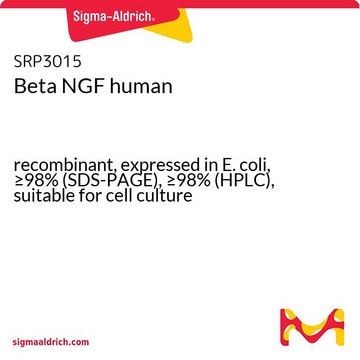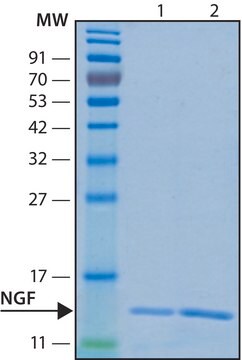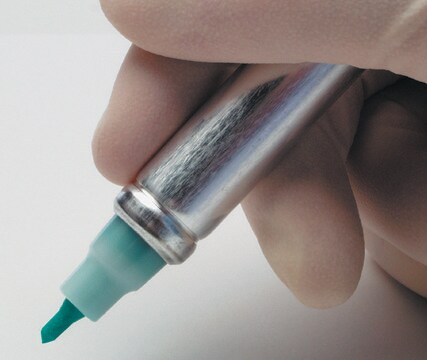NC010
Nerve Growth Factor 7.0s
Synonyme(s) :
holo-NGF
Se connecterpour consulter vos tarifs contractuels et ceux de votre entreprise/organisme
About This Item
Code UNSPSC :
12352207
eCl@ss :
32160405
Nomenclature NACRES :
NA.41
Produits recommandés
Source biologique
mouse
Essai
97% (SDS-PAGE)
Forme
solid
Fabricant/nom de marque
Chemicon®
Concentration
1 mg/mL
Numéro d'accès UniProt
Conditions d'expédition
dry ice
Informations sur le gène
mouse ... KLK4(56640)
Description générale
In the mouse submaxillary gland the neurotrophically active NGF, beta-NGF (2.5S), is part of a larger protein complex, 7S-NGF, which has the stoichiometry alpha2betagamma2 (+ 1 or 2 zinc ions) where the alpha and gamma subunits are members of the glandular kallikrein family of serine proteases, each of about 26 000 kDa molecular weight. The alpha and gamma subunits actually inhibit beta-NGF action and must be dissociated for biological activity to be observed.
This 7S complex has not been shown to occur in other mouse tissues, or in other species, probably because the alpha and gamma subunits, which are members of a larger glandular kallikrein family, apparently have a very restricted expression. The alpha and gamma subunits, members of the serine proteinase family, have quite similar amino acid sequences, although only the gamma subunit is catalytically active. The alpha subunit has undergone several mutations that preclude this function, including loss of the cleavage site needed for processing from the zymogen to the active form.
This 7S complex has not been shown to occur in other mouse tissues, or in other species, probably because the alpha and gamma subunits, which are members of a larger glandular kallikrein family, apparently have a very restricted expression. The alpha and gamma subunits, members of the serine proteinase family, have quite similar amino acid sequences, although only the gamma subunit is catalytically active. The alpha subunit has undergone several mutations that preclude this function, including loss of the cleavage site needed for processing from the zymogen to the active form.
MOLECULAR WT.:
130-140 kD. 7S NGF is composed of 3 subunits; 1 beta subunit (2.5S), 2 alpha subunits and 2 gamma subunits.
130-140 kD. 7S NGF is composed of 3 subunits; 1 beta subunit (2.5S), 2 alpha subunits and 2 gamma subunits.
Product Source: Mouse submaxillary gland (Darling & Shooter, 1984).
Application
The recommended concentration to be used in vitro for maintenance of sympathetic and immature sensory nerve cells is 50-100 ng/mL medium (Varon et al., 1967).
Forme physique
Lyophilized. NC010 should be reconstituted with sterile DMEM at a concentration of
10 μg/mL and stored at -70°C. Medium with mNGF cannot be reused due to mNGF degradation.
10 μg/mL and stored at -70°C. Medium with mNGF cannot be reused due to mNGF degradation.
Stockage et stabilité
Maintain at -20°C in undiluted aliquots for up to 6 months. Avoid repeated freeze/thaw cycles.
Remarque sur l'analyse
Specific Activity: The neurotrophic activity is in the range of 0.5-50 ng/mL using rat PC12 cells cultured for 7-14 days
Informations légales
CHEMICON is a registered trademark of Merck KGaA, Darmstadt, Germany
Clause de non-responsabilité
Unless otherwise stated in our catalog or other company documentation accompanying the product(s), our products are intended for research use only and are not to be used for any other purpose, which includes but is not limited to, unauthorized commercial uses, in vitro diagnostic uses, ex vivo or in vivo therapeutic uses or any type of consumption or application to humans or animals.
Code de la classe de stockage
11 - Combustible Solids
Classe de danger pour l'eau (WGK)
WGK 1
Point d'éclair (°F)
Not applicable
Point d'éclair (°C)
Not applicable
Certificats d'analyse (COA)
Recherchez un Certificats d'analyse (COA) en saisissant le numéro de lot du produit. Les numéros de lot figurent sur l'étiquette du produit après les mots "Lot" ou "Batch".
Déjà en possession de ce produit ?
Retrouvez la documentation relative aux produits que vous avez récemment achetés dans la Bibliothèque de documents.
The isolation of the mouse nerve growth factor protein in a high molecular weight form.
S Varon et al.
Biochemistry, 6(7), 2202-2209 (1967-07-01)
Notre équipe de scientifiques dispose d'une expérience dans tous les secteurs de la recherche, notamment en sciences de la vie, science des matériaux, synthèse chimique, chromatographie, analyse et dans de nombreux autres domaines..
Contacter notre Service technique








